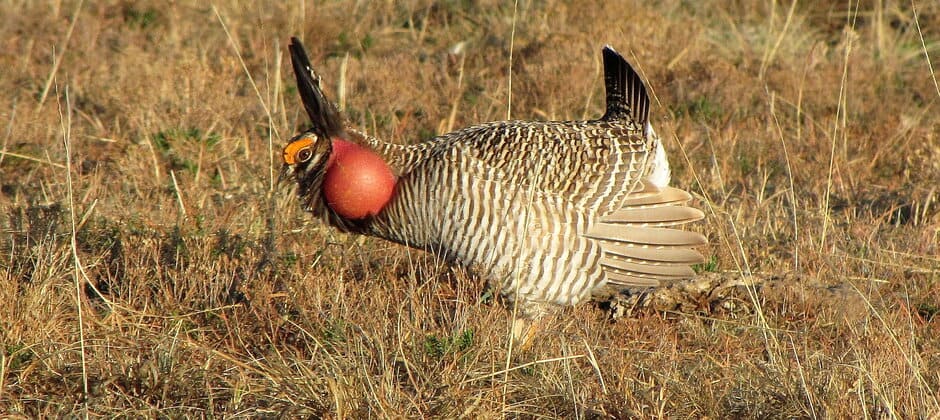Share this article
USFWS proposes ESA listing for lesser prairie chickens
Under a new proposal from the U.S. Fish and Wildlife Service, lesser prairie chicken (Tympanuchus pallidicinctus) populations would be listed under the Endangered Species Act.
The proposal, released on June 1 as part of a legal settlement agreement, cites a dramatic decline in the species’ populations, mostly due to habitat loss and fragmentation.
If passed, the southern distinct population in eastern New Mexico and the southwest Texas Panhandle would be classified as an endangered species. The northern distinct population in the northeast Texas Panhandle, southeast Colorado, south-central Kansas and western Oklahoma would be listed as threatened.
The lesser prairie chicken’s historical range included Colorado, Kansas, New Mexico, Oklahoma and Texas. However, the USFWS estimates that the species no longer occupies up to 90% of that area. While lesser prairie chickens once numbered in the hundreds of thousands, recent USFWS estimates put the current total population at only 27,384. The lesser prairie chicken is currently managed under the Lesser Prairie Chicken Range-wide Conservation Plan, a series of voluntary measures administered by the Western Association of Fish and Wildlife Agencies.
The USFWS does not plan to designate critical habitat for the lesser prairie chicken as part of the listing proposal. Noting that “a careful assessment of the economic impacts that may occur due to a critical habitat designation is not yet complete,” the agency indicated that it will designate critical habitat at a later date. Under the ESA, it has one year after the time of the listing to complete that designation.
The proposal does include what is known as a ‘4(d) rule’ — a special rule created for threatened species that allows certain actions to continue when those actions are not considered detrimental to the overall recovery of the species. The 4(d) rule for the threatened population of lesser prairie chickens would allow certain agricultural activities (such as plowing and other mechanical manipulation and management of lands, infrastructure maintenance and chemical use) and controlled fires even if those activities incidentally kill, harm or harass prairie chickens, as long as the parties performing those action commit to certain specified conservation practices.
The current listing proposal is the end result of a 2019 lawsuit brought by the Center for Biological Diversity and other environmental groups. However, the application of ESA protections to prairie chickens has been contested for years. The species was first made a candidate for listing in 1998, but no formal action was taken until 2014, when the species was listed as threatened. However, the oil and gas industry, among others, challenged that decision, and it was struck down by the court in 2015 because the agency did not give enough weight to the potential positive impacts of the habitat conservation plan developed by state wildlife agencies and other partners in deciding to list. The Obama administration dropped its appeal of the court’s decision in 2016. Soon after, the Center for Biological Diversity and others filed a petition for listing. When the USFWS failed to take timely action on that petition, the plaintiffs filed the 2019 lawsuit.
Comments will be accepted until Aug. 2. The USFWS plans to hold two virtual public hearings on the proposed rule on July 8 and July 14.
Read TWS’ Standing Position on Threatened and Endangered Species in the U.S. and Position Statement on the U.S. Endangered Species Act
Header Image: A U.S. Fish and Wildlife Service proposal would list the lesser prairie chicken under the Endangered Species Act. Credit: Tony Ifland / USFWS








